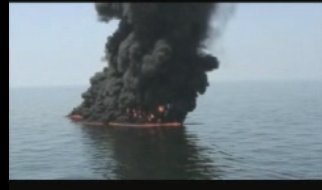
On Thursday, a pair of 60-foot shrimpers tugged a specialized, U-shaped boom through a 10,000-square-foot oil slick -- "pudding," they call the oil -- ten miles from the site of the Deepwater Horizon rig. When ignited, the boom transformed the oil into a roaring mass of flames as high as 150 feet and a column of smoke of biblical proportions (see below video, courtesy of the Coast Guard, shot from a helicopter).
In half an hour, 21,000 gallons -- 90 to 95 percent of the oil -- were burned.
This was one of approximately 200 such efforts in the past six weeks, according to Al Allen, CEO of Seattle-based Spilltec, hired by BP to conduct controlled burns. Allen estimated that more than two-thirds of the boats are vessels of opportunity helmed by Gulf area fishermen, shrimpers mostly. The shrimpers' alacrity and singular knowledge of the waters, he says, have made them ideal for the job. They have managed slicks as large as 30,000 square feet--burning up to twenty barrels [840 gallons] per minute and 3,000 barrels in a single job. With greater availability of vessels of opportunity and better weather conditions of late, "in situ burning" (cleanup in which oil is burned directly where it spilled) has been increasingly relied upon.
"It's an incredibly valuable technology," Allen told me, adding, "The trade-off is black smoke for a few hours as compared to black oil on the beach."
Although in situ burning takes place at least 50 miles from shore, naturally it raises concerns about pollution. In order to ensure safety, the Environmental Protection Agency is monitoring air quality. Meanwhile, reports have emerged of immediate peril to wildlife, such as sea turtles. The National Oceanographic and Atmospheric Administration offers guidelines to mitigate such casualties.
Overall, NOAA's Incident Operations Coordinator Doug Helton agrees with Allen, to an extent. "We think the decision to burn oil at sea is reducing the overall environmental impact," Helton told me. "Once oil's been spilled, there's no good outcome, there are just least-worst outcomes."
